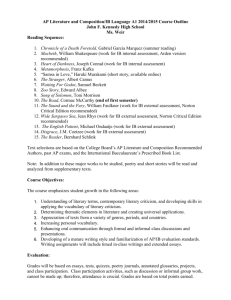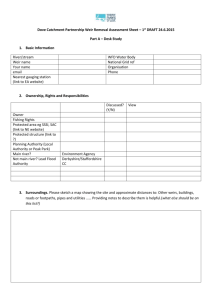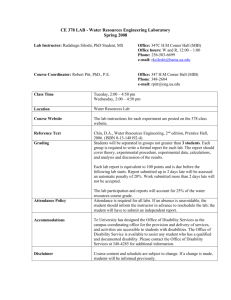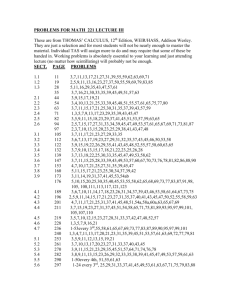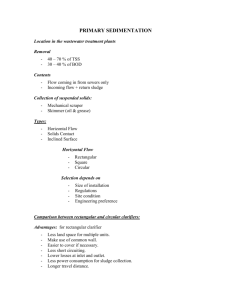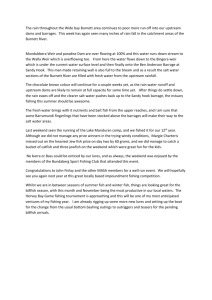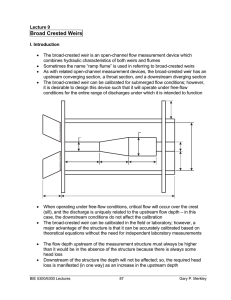TUTORIAL 1 - School of Civil Engineering
advertisement
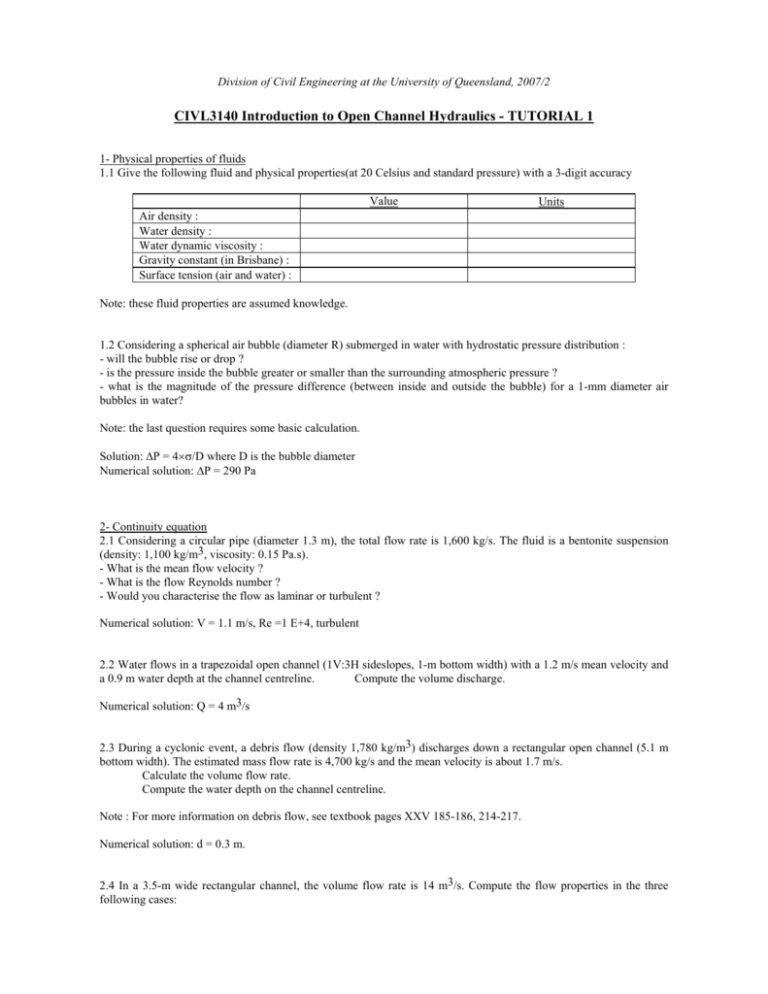
Division of Civil Engineering at the University of Queensland, 2007/2
CIVL3140 Introduction to Open Channel Hydraulics - TUTORIAL 1
1- Physical properties of fluids
1.1 Give the following fluid and physical properties(at 20 Celsius and standard pressure) with a 3-digit accuracy
Value
Units
Air density :
Water density :
Water dynamic viscosity :
Gravity constant (in Brisbane) :
Surface tension (air and water) :
Note: these fluid properties are assumed knowledge.
1.2 Considering a spherical air bubble (diameter R) submerged in water with hydrostatic pressure distribution :
- will the bubble rise or drop ?
- is the pressure inside the bubble greater or smaller than the surrounding atmospheric pressure ?
- what is the magnitude of the pressure difference (between inside and outside the bubble) for a 1-mm diameter air
bubbles in water?
Note: the last question requires some basic calculation.
Solution: ∆P = 4×σ/D where D is the bubble diameter
Numerical solution: ∆P = 290 Pa
2- Continuity equation
2.1 Considering a circular pipe (diameter 1.3 m), the total flow rate is 1,600 kg/s. The fluid is a bentonite suspension
(density: 1,100 kg/m3, viscosity: 0.15 Pa.s).
- What is the mean flow velocity ?
- What is the flow Reynolds number ?
- Would you characterise the flow as laminar or turbulent ?
Numerical solution: V = 1.1 m/s, Re =1 E+4, turbulent
2.2 Water flows in a trapezoidal open channel (1V:3H sideslopes, 1-m bottom width) with a 1.2 m/s mean velocity and
a 0.9 m water depth at the channel centreline.
Compute the volume discharge.
Numerical solution: Q = 4 m3/s
2.3 During a cyclonic event, a debris flow (density 1,780 kg/m3) discharges down a rectangular open channel (5.1 m
bottom width). The estimated mass flow rate is 4,700 kg/s and the mean velocity is about 1.7 m/s.
Calculate the volume flow rate.
Compute the water depth on the channel centreline.
Note : For more information on debris flow, see textbook pages XXV 185-186, 214-217.
Numerical solution: d = 0.3 m.
2.4 In a 3.5-m wide rectangular channel, the volume flow rate is 14 m3/s. Compute the flow properties in the three
following cases:
Flow depth :
Cross-section area :
Wetted perimeter :
Mean flow velocity :
Froude number :
Specific energy :
Case 1
0.8
Case 2
1.15
Case 3
3.9
Units
m
Notes :
- the wetted perimeter is the perimeter of contact between the fluid and the solid boundary, in a cross-section normal to
the flow direction (see textbook page XXXVIII);
- the definition of the specific energy is given in textbook p. 29-30 : E = H - zo.
3- Application of the continuity and Bernoulli equations to a broad-crested weir
A broad-crested weir is a flat-crested structure with a crest length large compared to the flow thickness. The ratio of
crest length to upstream head over crest must be typically greater than 1.5 to 3. Critical flow conditions occur at the
weir crest. If the crest is "broad" enough for the flow streamlines to be parallel to the crest, the pressure distribution
above the crest is hydrostatic and critical depth is recorded on the weir.
Considering a horizontal rectangular channel (B = 15 m), the crest of the weir is 1.2 m above the channel bed.
Investigate the following two upstream flow conditions and complete the following table. Assume a supercritical
downstream flow.
Upstream flow depth
Upstream Froude number
Flow depth above the weir crest
Upstream specific energy :
Velocity above the crest :
Specific energy above the crest :
Downstream flow depth :
Downstream Froude number :
Downstream specific energy
Volume discharge :
Case 1
1.45 m
Case 2
2.1 m
3.195 m3/s
Notes :
- For more information on broad-crested weirs, see textbook pages 37-38 & 396-397.
- For a horizontal rectangular channel, the Froude number is defined as : Fr = V/ g×d.
- The solution of case 2 requires the solution of a cubic equation. See textbook pp. 138-140.
Solution: The solution of case 1 is trivial. Case 2 is solved by combining the continuity equation and the Bernoulli
principle for a short an smooth transition. Since the upstream flow is subcritical (check it), and since the downstream
flow is supercritical, critical flow conditions must take place above the weir crest. That is, d2 = dc =
Numerical solution : Case 2: d1 = 2.1 m, ∆z = 1.2 m, Q = 22.8 m3/s,
3
Q2/(g×W).
d3 = 0.25 m (d/s depth)
4- Application of the basic principles to a broad-crested weir
Considering a broad-crested weir, draw a sketch of the weir in a rectangular horizontal channel.
(4.1) What is the main purpose of a broad-crest weir ?
A broad-crested weir is installed in a horizontal and smooth channel of rectangular cross-section. The channel width is
10 m. The bottom of the weir is 1.5 m above the channel bed. The water discharge is 11 m3/s and the upstream water
depth is 2.235 m.
(4.2) Compute the depth of flow downstream of the weir in absence of downstream control, assuming that critical flow
conditions take place at the weir crest.
(4.3) Calculated the horizontal, sliding force acting on the weir. Give the direction of the force exerted by the flow onto
the sill.
Solution
(4.1) For more information on broad-crested weirs, see textbook pages 37-38 & 396-397.
(4.2) Question (4.2) is based upon the application of the continuity and Bernoulli principles.
(4.3) Question (4.3) is based upon the application of the momentum principle.
Numerical solution : d2 = 0.173 m, Fsliding = 178 kN (The force exerted by the fluid onto the weir sill acts in the
downstream direction.)
5- Application of the basic principles to a sluice gate
An undershot sluice gate is in a channel 5 m wide and the discharge Q is 4 m3/s. The upstream flow depth is 1.2 m. The
bed of the channel is horizontal and smooth.
(5.1) Sketch the sluice gate flow.
(5.2) Draw on your sketch the variation of the pressure with depth at sections 1 and 2, and on the upstream face of the
sluice gate. Sections 1 and 2 are located far enough from the sluice gate for the velocity to be essentially horizontal and
uniform.
(5.3) Show on your figure the forces acting on the control volume contained between sections 1 and 2. Show also your
choice for the positive direction of distance and of force.
(5.4) Write the Momentum equation as applied to the control volume between sections 1 and 2, using the sign
convention you have chosen. Show on your figure the forces and velocities used in the Momentum equation.
(5.5) Compute and give the values (an units) of the specified quantities in the following list :
(a) Velocity of flow at section 1. (b) Specific energy at section 1. (c) Specific energy at section 2. (d) Assumption used
in answer (c). (e) Depth of flow at section 2. (f) Velocity of flow at section 2. (g) The force acting on the sluice gate.
(h) The direction of the force in (g) : i.e. upstream or downstream. (i) The critical depth for the flow in figure 1. (j)
What is maximum possible discharge per unit width for a flow with Specific Energy entered at (b) ? (This question is a
general question, not related to the sluice gate.)
Numerical solution: Q = 4 m3/s, d1 = 1.2 m, d2 = 0.18 m, FG = 1.9 E+4 N
More exercises in textbook pp. 8, 19-20, 46-49, 111-118.
"The Hydraulics of Open Channel Flow: An Introduction", Butterworth-Heinemann Publ., Oxford, UK, 2004.
More Exercises at : {http://www.bh.com/companions/0340740671/}
Go to Exercises, Part 1 : {http://www.bh.com/companions/0340740671/exercises/exercisesP1.htm}
